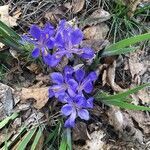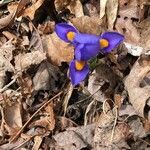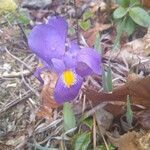Rhizomes heterogeneous, whitish, cordlike portions 0.1–1.5 dm × 2–4 mm, enlarging to 6–8 mm diam., densely covered with brown, scalelike leaves, roots absent, or torulose with roots borne along entire rhizome. Stems simple, 5–15 cm. Leaves: basal with blade light green, ensiform, 0.3–1.5 dm × 0.3–1.3 cm, enlarging to 3.5 dm, glaucous; cauline 5–9, sheathing, imbricate, blade light green, obovate, 1.3–5 cm, increasing in length, proximal shortest, membranous, apex acute. Inflorescence units 1–2-flowered; spathes divergent, exposing floral tube, green, lanceolate, 2–2.5 cm, apex acuminate. Flowers: floral tube pale violet, filiform, 2.5–6.5 cm, expanding somewhat distally to 2.5–4 cm diam.; sepals widely spreading, blue to violet with yellow or orange longitudinal papillose band at base of blade, obovate, 2–6 × 0.8–2 cm, base gradually attenuate into claw, not crested; petals erect, arching inward at tip, spatulate, 2–7 × 1–2 cm, base abruptly attenuate into claw; ovary linear, to 1.3 cm; styles pale violet, 2.5–4 cm, crests linear-acute, narrow, 0.7 cm; stigmas rounded, margins entire; pedicel 1–3 cm, increasing to 25 cm as capsule matures. Capsules 3-angled with single ridge at each angle, almost hidden in bases of spathes, 1–3.2 × 0.8–1.5 cm, tapering into beak consisting of dried remnant of floral tube. Seeds dark brown, ribbed, 2.8–3.2 mm, lustrous, with small, fleshy aril basally.
More
Lvs grass-like, bright green, glaucous on one side, 3–4 cm × 3–10 mm at anthesis, later much elongate; spathe 1–2-fld, the valves pale green to whitish or pink-tinged, rather closely sheathing each other; perianth-tube dull green, ± exceeding the spathe-valves, the limb 5–6 cm wide, bright violet (pale or white); sep spreading or recurved; with a broad, yellow, papillose-hairy band extending from the middle of the blade into the claw and frequently surrounded by white markings; pet erect, with long slender claw and obovate blade; fr obtusely 3-angled, slender-beaked, 1.5–2.5 cm; seeds arillate; 2n=42. Sandy open woods and pine-lands. Pa. to Ky., Miss. and Ga. Apr., May. (Neubeckia v.)
Can be grown by divisions or seedlings. Seeds needs stratification.



